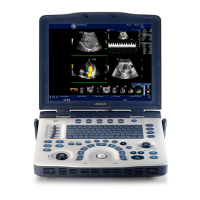Quality Assurance
LOGIQ V2/LOGIQ V1 – User Guide 3-63
Direction 5610736-100 Rev. 9
Lateral resolution
Description
Lateral resolution is the minimum reflector separation between
two closely spaced objects to produce discrete reflections
perpendicular to the axis of the sound beam. It can also be
monitored by checking the horizontal size of known pin targets.
See Figure 3-35 for more information.
Lateral resolution is dependent upon the beam width produced
by the probe. The narrower the beam, the better the lateral
resolution.
The beam width is affected by the frequency, degree of focusing,
and distance of the object from the face of the probe.
Benefit
Clinically, poor lateral resolution will display small structures
lying close together as a single dot. This may lead to improper
interpretation of the ultrasound image.
Procedure
To measure lateral resolution:
1. Scan a test phantom with precisely-spaced horizontal pin
targets.
2. Adjust all scan controls, as necessary, for the best image of
the pin targets from side to side.
3. Press Freeze to stop image acquisition and perform a
standard distance measurement of the horizontal thickness
of a pin at different points in the image. Record all images
for archiving.
4. Scan the horizontal pins in zoom or at different depth/scale
factors.
5. Press Freeze to stop image acquisition; repeat the
horizontal thickness measurements of the pins and record
the images for archiving.
6. Document the measurements for reference and future
comparison.
Pin width should remain relatively constant over time ("1mm).
Dramatic changes in pin width may indicate beamforming
problems. Contact a Service Engineer if beam width changes
consistently over 2 to 3 periodic tests.

